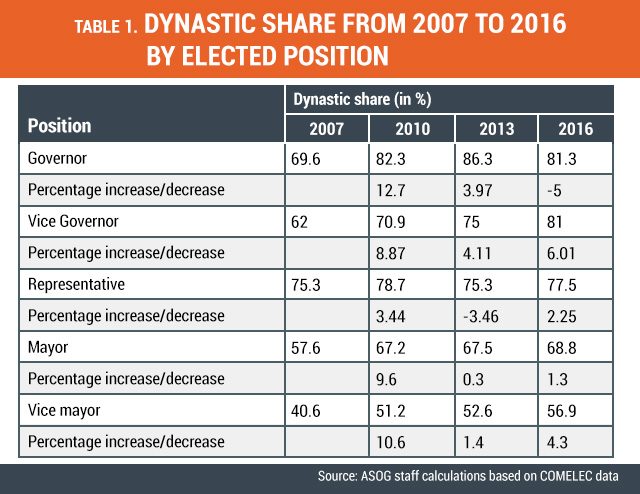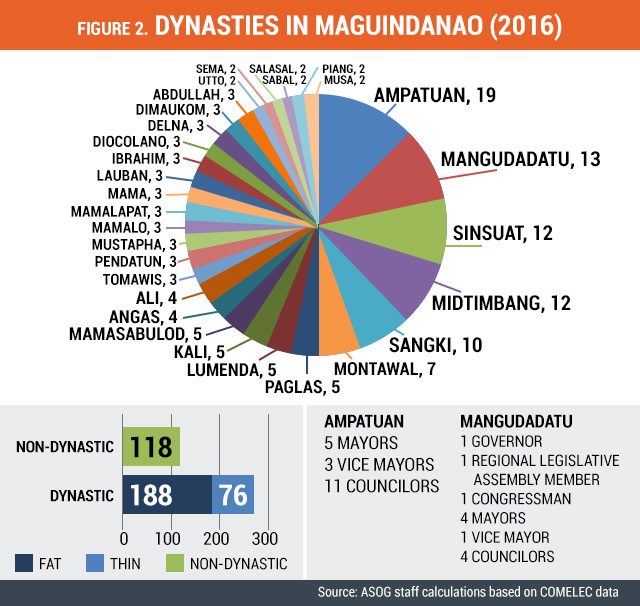SUMMARY
This is AI generated summarization, which may have errors. For context, always refer to the full article.

The 2016 national elections seem so far away in distant memory now; but the official statistics on the elections only recently released and analyzed, should spur the country to think deeply about its democratic future.
Some analysts point to the expansion of dynasties under the country’s decentralized governance set-up. And still others note the increased risks if we deepen this with a federalism initiative. While the country has no doubt produced exceptional local government leaders, the evidence seems to suggest that we are producing more Andal Ampatuans rather than Jesse Robredos.
This article provides an update on the local government leadership patterns in the country, incorporating the results from the May 2016 elections. Overall, the Philippines’ local governments have become more and more dynastic since 2007 (see Figure 1).

Most dynastic provinces and positions
All of the top positions in each major local government unit appear to be dominated by dynasties: over 81% of governors and vice governors, and around 78% of representatives (see Table 1).

If we measure dynastic prevalence as the share of political dynasties out of the total elective positions in a province (e.g., governor, vice governor, mayors, representatives, councilors), then the most dynastic province in the country is also our country’s fourth poorest, Maguindanao.
Over time, stretching from 2004 to 2016, the most dynastic provinces appear to have remained so – and new dynasties have begun to dominate additional provinces like Cavite and Catanduanes (see Table 2).

The fact that dynastic growth can be observed across the country suggests that this is not merely a cultural phenomenon one can attribute to the Muslim South.
In a majority of these provinces, political dynasties from the same families have been dominating these provinces for well over a decade now. And that dominance, it seems, can only be degraded by other political clans rising up to compete with the larger dynasties. This signals a complete deterioration of inclusiveness in our democratic leadership selection – only the moneyed and those with the correct last name appear to enjoy the entitlement of leadership.
For example, the Ampatuans in Maguindanao were recently toppled by the Mangudadatus, and the Espinosas in Masbate were eventually displaced by the Khos and the Seachon-Lanetes (see Figure 2). Very few, if any, new leaders were produced in these areas.

Masbate is a particularly interesting case – 4 of its congressmen were assassinated between 1989 and 2005, signaling the intense and vicious competition for Masbate’s leadership. During the entire period, poverty in Masbate deepened – one in two Filipinos in Masbate lives below the poverty line.
In many parts of the country, “political competition” under these circumstances brings about a merry-go-round of dynastic families in power, with very little fundamental change in governance or development outcomes on the ground.
Dynasties thriving under decentralization?
To be sure, not all dynasties are corrupt, criminals and murderers – but the overall pattern of governance dominated by dynastic clans is definitely associated with sub-par development outcomes, on average across all local government leaders, if we look at the evidence.
There are many reasons for this – and distortions in public finance are among the main ones. For instance, disaster reconstruction funds are historically allocated based on clan ties, according to a study by University of Michigan economists, including Nico Ravanilla and Allan Hicken. In addition, Joseph Capuno of the University of the Philippines found evidence that gerrymandering (the creation of new political jurisdictions) favors the expansion of political clans.
Finally, several studies by the Asian Development Bank, Asian Institute of Management, Ateneo and Univerity of the Philippines economists show how political dynasties thrive in the poorest and most underdeveloped regions in the Philippines, where human development and economic progress fail to take root.
There is strong evidence that the growth of fat dynasties (i.e. “sabay-sabay nanunungkulan” or serving at the same time) is associated with deeper poverty, notably in the provincial periphery, where warlordism and traditional politics thrive to this day.
As noted by Alex Lacson (author of 12 Things Every Filipino Can Do to Help Our Country) the country kicked out a dictator in 1986, but he was replaced by many “mini-dictators” in the provinces ever since. No wonder then that the promise of freedom and development after EDSA has proved elusive. This does not, however, justify or rationalize a return to authoritarianism.
The real challenge for reformists lies in correcting the deep-seated political and economic inequality that existed under Marcos, and continues to persist and divide the country today.
If decentralization (or broader, federalism) is to work, leadership selection must first be made more inclusive and competitive; and the distortions in our public finance must be replaced by a better working and more disciplined fiscal federalism. – Rappler.com
*The views expressed in this article are the authors’ and do not necessarily reflect those of the Ateneo de Manila University. Further data and references on this article are available here.
Add a comment
How does this make you feel?
There are no comments yet. Add your comment to start the conversation.